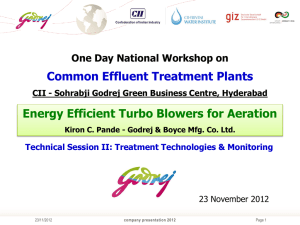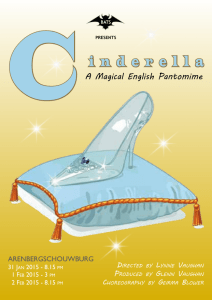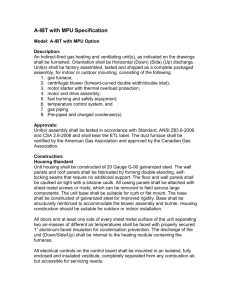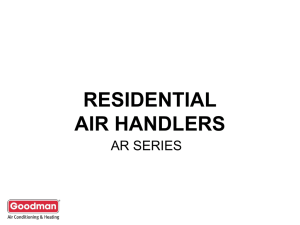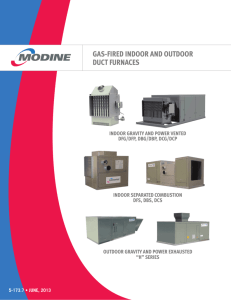When replacing blower wheel assembly on installed coolers that
advertisement
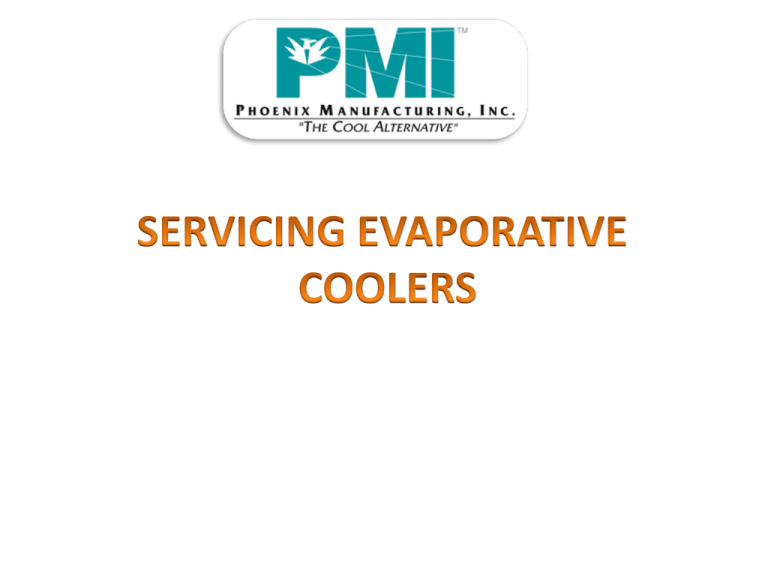
Sleeve Bearing • PMI uses a sintered bronze bearing on the blower assembly. • The bronze bearing is surrounded by a permawick felt that holds the oil. The 20 or 30 weight non detergent oil then permeates thru the bearing’s microscopic pores onto the blower shaft. • Never use light oils (Zoom oil) for bearings. Light oils act as a solvent and washes out the heavier lubricant. Permawick Felt Replacing Blower Wheel Assembly When replacing blower wheel assembly on installed coolers that have the ductwork installed, it will require that the complete blower assembly be removed from the cooler. Remove (4) ¼” -20 x1/2 bolts from front flange (side discharge units) or duct bottom flange (down discharge units). Remove the bolts from blower support brackets. Lift blower assembly from flanges. Remove cutoff baffle from assembly. Loosen blower wheel set screws. Pull pulley and shaft from blower wheel & remove wheel from the housing assembly. Replacing Blower Wheel Assembly Insert replacement blower wheel (Make sure the of direction of vanes curve towards duct opening). Insert shaft, add leather washer after inserting shaft thru bearing assembly. Insert shaft thru both blower wheel hubs, add leather washer and insert shaft thru bearing. (washer goes between wheel hub & bearing.) Leave 1 7/8 ” of shaft extended beyond bearing and then tighten set screw on blower wheel hub while squeezing blower wheel hub against leather washer and bearing. Replacing Blower Wheel Assembly On opposite of pulley side, pull blower wheel hub and leather washer against bearing, then tighten set screw. Returning to the pulley side, assemble blower pulley flush with the end of the shaft. Reattach cut-off baffle to blower assembly. Install blower assembly to duct flanges, replace bolts Fasten blower support brackets Replacing Aspen Pads • Lay pad frame on flat surface with aspen pad up. • Grab the side flange middle and pull outward to expose wire retainer, grab opposite side flange and pull retainer wire outward. • Grab retainer wire at bottom of pad frame and pull wire outward. • Remove wire retainer assembly from top of pad frame. • Remove aspen pad from pad frame. Replacing Aspen Pads con’t. • Lay new aspen pad on pad frame, start at top of pad frame, making sure the aspen pad is not tucked behind water trough. It must be just above water trough on blower side. • Adjust aspen pad to fill the frame, push aspen to all outer edges, Do Not leave any voids. • Insert pad retainer to top trough edge first, then insert bottom wires, and then each side edge. • Pre-wet pad frames before installing or run pump only to help aspen to wet out completely. Cooler Motor Installation • Install motor to motor cradle . Install motor so that the vent holes are in the downward position. This allows any water to drip from the motor case. • Align motor sheave (variable pulley ) with blower pulley. • • Pre-adjust variable sheave to 4 turns open. To achieve maximum output of cooler and set sheave to nameplate amps, make sure exhaust for the cooler is set to 2 square ft. per 1000 cfm. If the motor amperage is below nameplate amps readjust sheave inward until nameplate amps is achieved. Cooler Motor Installation • Excessive belt tension will add load to motor and will cause premature damage to motor and blower bearings. • For preseason start up, Cycle motor about 5 times (on and off ) without belt installed. This prevents start winding failures by self lubricating the horizontal shaft that the centrifugal switch slides on. • New evaporative motors have permanent lubricated bearings. Older motors had bronze bearings which required oiling. • Excessive belt tension will cause motor to overload. • All residential motors have thermal overload protection. • Frequent overload will cause motor to smoke and then it’s damaged. • If motor fails to start and is humming and it started by turning the belt, the motor start winding is gone. Servicing Pump • Aspen fibers and calcium deposits can cause affect pump performance. • Remove pump from cooler. • Remove plastic wire tie, slide notches thru slot on plastic tie wire. • Remove plastic screening. • Invert pump assembly. • Pry off round cleanout disc. • Inspect impeller and outlet. • Remove any deposits. Pro Cooler Thermostat Trouble Shooting Tips • Check input voltage, Check L1 on relay and neutral terminals, • Check 24 Volts DC at thermostat terminals • C to R =24 • Between C to H, C to L, C to P, C to D, you will read 24 VDC when thermostat is off. • When motor, pump and drain pump is energized by thermostat, voltage is .2 or less at that terminal. • Pro has 24 volt VDC thermostat control. • With thermostat wires removed from PC board terminals, motor and pump can be checked by jumping between C and H or L or P terminals. STAND PIPE ASSEMBLY FLOAT ASSEMBLY THANK YOU FOR YOUR TIME AND ATTENTION. IF YOU HAVE QUESTIONS IN THE FUTURE, YOU CAN CONTACT ME AT: ROBERT ORTEGA PHOENIX MANUFACTURING INC WARRANTY MANAGER 1-800-325-6952 ROBERT_ORTEGA@PHXMFG.COM
